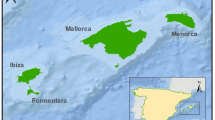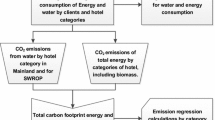Abstract
Recent studies indicate that global warming is worsening, tremendously affecting our environment.Hence, reducing CO2 emissions is one of the most pressing issues in environmental protection. Among the natural resources, water is one of the most vital. Having a clean and secure water supply, as well as a water distribution system, is crucial for modern society. From a life cycle perspective, a complete water supply system is complicated and contains substantial, embedded carbons, which comprise infrastructure, as well as purification facilities and related processes. Assessing the total carbon footprints of a complete water supply system would present numerous benefits. Such evaluation covers the examination of water supply efficiency and identifying opportunities for carbon emission reduction after a thorough inventory.In addition, calculating the carbon footprints of products has become increasingly important for global enterprises. Determining the carbon footprint of unit of water (i.e., in kgCO2 e/m3) is necessary for the calculation of a product’s carbon footprint.
In view of the above-mentioned issues, several countries, including Scotland, the UK, USA, Japan, and Italy, have studied the carbon footprints of water supply systems. In Taiwan, previous studies conducted to determine the carbon footprints of water supply systems were not based on a life cycle perspective.Commissioned by the Water Resources Agency of the Ministry of Economic Affairs, this study calculated the carbon footprints of five water supply systems, each with different characteristics in terms of topography, scale, raw water quality, and purification process. The water supply systems studied included a traditional purification plant, a purification plant with high-turbidity raw water, a multi-process purification plant, an advanced purification plant, and a desalinization plant. The scope of inventory and assessment includes the intake, the purification, and the distribution stages, as well as the infrastructure and the chemicals used that are associated with these stages. Carbon footprints are calculated based on the unit water sold (m3). The calculation is performed in accordance with the standards set by the Taiwan Carbon Footprint Calculation Guidance for Products and Services. Preliminary results show that the carbon footprints of the traditional purification plant, the purification plant with high-turbidity raw water, the desalination plant, the advanced purification plant, and multi-process purification plant are 0.1768, 0.2646, 9.6249, 0.4969, and 0.1942 kg CO2e/m3, respectively.
Access this chapter
Tax calculation will be finalised at checkout
Purchases are for personal use only
Preview
Unable to display preview. Download preview PDF.
Similar content being viewed by others
References
Intergovernmental Panel on Climate Change (IPCC) (2007): Working Group III Report "Mitigation of Climate Change " - Complete online versions.
Caffoor, I., Perspective (2009): a vision of a low- carbon water sector in 2050, Proceedings of the ICE - Engineering Sustainability, Vol. 163(1), pp. 9-14.
Taiwan Water Corporation network (2006), http://www.water.gov.tw/eng/index.asp
Allen H. Hu, Li-Hsiang Wang, Yu-Zih Lin, Ching- Wen Fan, Jia-Hung Lin, Kai-Fu Yao, Jia-Gang Ao, Yu-Ting Feng and Wan-Mu Guo(2011): Carbon Footprint Assessment of Water Supply System in Taiwan- Boundary and Scope for Calculation, Sustainable urban and green management.
Wackernagel, M. and Rees, W.E.(1996): Our Ecological Footprint - Reducing Human Impact on the Earth. New Society Publishers Gabriola Island, B.C., Canada.
Wiedmann, T. and Minx, J. (2007): A Definition of "Carbon Footprint". ISAUK Research Report 0701.
Klopffer, W., (1997): Life Cycle Assessment-from the Beginning to the Current State, Environ Sci PollutRes Int, Vol.4, pp. 223-228.
Mohamed El-Sayed Mahamed Mahgoub, Nico Peter van der Steen, Khaled Abu-Zeid, and Kala Vairavamoorthy (2010): Towards Sustainability in Urban Water : a Life Cycle Analysis of the Urban Water System of Alexandria City, Egypt, Journal of Cleaner Production, Vol.18, pp1100-1106.
Maurice B, Frischknecht R, Coelho-Schwirtz V and Hungerbühler K.,(2000): Uncertainty Analysis in Life Cycle Inventory: Application to the Production of Electricity with French Coal Power Plants, Journal of Cleaner Production, Vol.8, pp. 95-108.
Heather L, MacLean and Lave L B. (2003): Evaluating Automobile Fuel/propulsion System Technologies, Progress in Energy and Combustion Science, Vol. 29, pp. 1-69.
Environmental Protection Administration (2010): Taiwan Carbon Footprint Calculation Guidance for Products and Services, Taiwan.
Emilia-Romagna Development Agency (2009): Water Distribution through Mains, except steam and hot water. GEDNET.
Wahidul K. Biswas (2009): Life Cycle Assessment of Seawater Desalinization in Western Australia, World Academy of Science, Engineering and Technology, Vol.56, pp.369-375.
Scottish Water (2009): Scottish Water Carbon Footprint Report, 2007-2008, Scottish.
Scottish Water (2010): Scottish Water Carbon Footprint Report, 2008-2009, Scottish.
Environment Agency (2008): Greenhouse gas emissions of water supply and demand management options, Science Report- SC070010.
Friedricha, E., Pillayb, S. and Buckleyb, C.A. (2009): Carbon footprint analysis for increasing water supply and sanitation in South Africa: a case study, Journal of Cleaner Production, Vol. 17(1), pp. 1-12.
River Network, U.S. khttp://www.rivernetwork.org
National Science Council (2006): The Study of Carbon Dioxide Emission of Piped Water in Taiwan, Taiwan
Japan Water Research Center (2008)
Author information
Authors and Affiliations
Editor information
Editors and Affiliations
Rights and permissions
Copyright information
© 2012 Springer Science+Business Media Dordrecht
About this paper
Cite this paper
Hu, A.H. et al. (2012). Carbon Footprint Assessment of Water Supply Systems in Taiwan. In: Matsumoto, M., Umeda, Y., Masui, K., Fukushige, S. (eds) Design for Innovative Value Towards a Sustainable Society. Springer, Dordrecht. https://doi.org/10.1007/978-94-007-3010-6_61
Download citation
DOI: https://doi.org/10.1007/978-94-007-3010-6_61
Publisher Name: Springer, Dordrecht
Online ISBN: 978-94-007-3010-6
eBook Packages: Earth and Environmental ScienceEarth and Environmental Science (R0)




